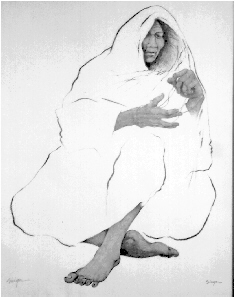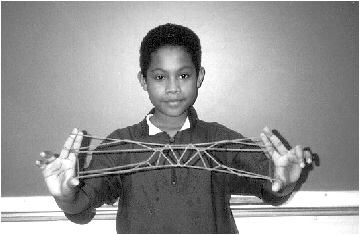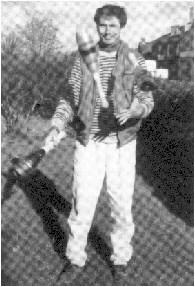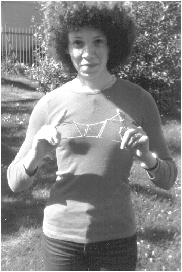
1998 membership dues
This year renewal notices were mailed in late January. As in previous years, US $25 was requested to help offset the cost of printing and mailing our Bulletin, Magazine, and Newsletter (~$6000/yr). However, this year an additional $10 was requested from overseas members wishing to receive our four mailings by airmail. If you did not receive a renewal notice don't fret -- your membership is active through 1998.
The editor wishes to extend a special thanks to the eighteen "string figure angels" who contributed more than the requested amount. Your generosity is much appreciated.
Welcome New Members
During the past six months ISFA acquired twenty-four new members. So far, thirty-one members have failed to renew for 1998. We now have 115 members residing in eighteen countries.
Our new members are: Jim Hooper, Brisbane, Australia; In Canada S. Abraham, Vancouver, British Columbia, Clare Stewart and daughter Elizabeth Sneyd, Hamilton, Ontario, Gillian Story, Calgary, Alberta, and Gail de Vos, Edmonton, Alberta; Vivian Branson, Sevenoaks, England; Guy Massat, Paris, France; Axel Reichert, Bad Oldesloe, Germany; Harald Richter, Pfaffenweiler, Germany; Ian Stewart, Coventry, England; Hiroki Shimizu, Yokohama, Japan; Leslie Bartlett, Rockport, Massachusetts; Brett Becker, Kansas City, Kansas; Deborah Burhard, Atlanta, Georgia; Dante Carfagna, Kansas City, Missouri; Douglas Danielson, Otsego, Michigan; Janet Hunter, East Lansdowne, Pennsylvania; Mary Ritchie Key, Irvine, California; William Lawrence, Centralia, Washington; Steve Newkirk, Ojai, California; Britt Scharringhausen, Ithaca, New York; and Agnes Tomorrow, Seattle, Washington. Rejoining us are Tadahiro Kanauchi, Tokyo, Japan; and Tim Kennedy, Fargo, North Dakota. Welcome!
Dover to Reprint String Figure Magazine
ISFA Press is proud to announce that Dover Publications of Mineola, New York, has purchased the rights to reprint portions of String Figure Magazine in book form. Dover is a major publisher of craft and hobby books, including several important string figure titles (C.F. Jayne, "String Figures and How to Make Them", W.W. Rouse Ball, "Fun with String Figures", and J. Leeming, "Fun with String".). Their books are available in nearly every US book store and are often quite inexpensive.
The forthcoming book, tentatively scheduled for Fall release, will include a selection of figures extracted from six back issues of our Magazine. In exchange for reprint rights a flat fee has been offered (enough to finance the printing of our Magazine for another year). Also, the editors have agreed to mention ISFA's address in the introduction, which means we can expect a significant increase in membership in the near future. Let's hope for a sequel!
First International Gathering Update
Plans for our July 9-12 meeting at the Winnipeg Folk Festival are now being finalized. Coordinator Brian Cox has reserved meeting space for us in the Family Area. So far eight members have expressed an interest in attending (Mark Sherman, Will Wirt, Jonathan Neufeld, C.J. Hartman, Audrey Small, Tom Cutrofello, Tim Kennedy, and Joe D'Antoni). Brian envisions the following schedule of events:
Thursday, July 9th
Evening session (7:00-10:00) - ISFA members and guests:
Friday, Saturday, and Sunday, July 10th - 12th
Afternoon sessions (12:30-6:00) - open to general public:
The focus of our afternoon sessions will be to instruct and entertain Folk Festival attendees. ISFA members may participate to whatever extent they wish. As an incentive, Brian has arranged for five afternoon performers/workshop organizers to receive free admission to the Festival, a significant discount on room rates at the International Inn, two free meals daily, and free shuttle service between the hotel and festival grounds. Audrey Small and Brian Cox have already expressed an interest in exhibiting their storytelling skills.
During our evening sessions ISFA members will have the opportunity to share figures, learn new techniques, and exchange literature. Mark Sherman has offered to demonstrate Easter Island figures (Pacific session) and Eskimo/Kwakiutl figures (Arctic session). Will Wirt plans to present some of the Guyanan/Peruvian figures he gathered (South American session) as well as his latest gems from Tibet and China (Asian session). C.J. Hartman is eager to share her experience using string figures in the classroom. In addition, Brian Cox would like to see a session devoted to large-loop, multi-loop, and multi-person figures.
A four-day pass to the festival sells for US $62 (Seniors $54) if purchased before May 31. In the US and Canada tickets may be purchased through Ticketmaster (1-888-655-5354). There is no registration fee for the ISFA meeting. For the latest information visit the Folk Festival web site at www.total.net/~wff/main.menu.html or call Brian at (204) 669-3697. A complete listing of hotels in the area can be found at www.adweb.com/accom-modations/manitoba/index.html or call Tourism Winnipeg at 1-800-665-0204 or (204) 943-1970. The Folk Festival is held at Birds Hill Provincial Park, located 15 miles northeast of Winnipeg.
ISFA Responds to Cat's Cradle Calculus Challenge
Much to everyone's surprise, cat's cradle was the subject of Ian Stewart's "Mathematical Recreations" column in the December issue of Scientific American. In it, Stewart points out that in the past decade much progress has been made by mathematicians in devising algebraic formulations for knots and braids. He then poses a challenge: "it ought to be possible to devise a neat calculus of cat's cradle, an algebra that describes how to get from the initial uninteresting loop to more significant shapes by making standard moves of various kinds." The article concludes with a presentation of the eight string figures that form the cat's cradle series, followed by a detailed description of how to make "Indian Diamonds" (Jacob's Ladder).
In response to the challenge several members suggested that Mark Sherman prepare a formal letter on behalf of ISFA. The letter, reviewed by members of our newly formed e-mail discussion group, was mailed in late December along with a hefty parcel containing Bulletins 1 through 4, four issues of our Magazine, and a photocopy of Tom Storer's two-volume monograph entitled String Figures, which presents an extensive mathematical analysis of string figures and tricks.
Within days Ian Stewart responded to our letter, graciously thanking us for the "vast amounts of material" we sent and enthusiastically offering to mention us in his Feedback column which routinely appears six months after the feature article. Needless to say, we are overjoyed at the prospect of being mentioned in Scientific American, whose circulation approaches 1 million copies worldwide. Publicity of this calibre is priceless -- thanks, Ian Stewart!
First Russian String Figure Book Now Available
From the Russian port city of St. Petersburg comes "Playing with String", by Elena and Alexandra Afonkina, the wife and daughter of ISFA member Sergei Afonkin. The Afonkins are known throughout Russia as the authors of several fine origami books and editors of an origami magazine. This is their first attempt at describing strings figures, and based on the beauty and accuracy of their illustrations (prepared by Alexandra), it won't be their last!
Although a full review will appear in this year's Bulletin, it's worth mentioning here that the 224-page book features step-by-step, illustrated instructions for making thirty-one string figures and tricks. The style is that of Gryski, with arrows used to indicate how the fingers should manipulate the strings. Granted, most of the string figures in this book are from previously published sources, including a few from our Magazine. But the descriptions and illustrations are entirely original and very well done.
ISFA Press has ordered a small stock of this rare volume for distribution to members of ISFA. To reserve a copy for your collection send us a note or e-mail message. The book is priced at US $10.
String Figure Discussion Group Alive and Well
Plans for an e-mail discussion group dedicated to string figures have materialized. The first message was relayed to participants on September 20, 1997. Since then, 182 messages have been posted. We now have forty-three participants representing eleven countries. The discussion group is administered and financed by Will Wirt of Port Angeles, Washington. Anyone with an e-mail address can participate. For details on how to join contact Will at wlwirt@olympus.net or visit our web site.
All messages sent to the discussion group are archived for future reference. You can access the archives using a web browser like Netscape or Microsoft Internet Explorer (the URL is home.dc.lsoft.com/archives/string-figures.html). Messages from the archives can also be downloaded using e-mail (contact Will for details).
Since not everyone has e-mail, a summary of previously discussed topics will appear regularly in our newsletter. If a specific topic interests you and you would like a printed copy of the initial message and the responses it generated, contact ISFA Press. Topics discussed since September include the following:
Other News of Interest
The latest issue of our Magazine (March 1998) includes over 100 original illustrations generously contributed by Joseph D'Antoni, of New York. Joe spends up to 2 hours drawing each illustration by hand -- no photographs are used! Of special interest are his illustrations for making the fiendishly difficult "Seal" (Paterson) and the lengthy series "Malaysian Fisherman" (Leakey), for which no previous illustrations exist. Readers will also enjoy the ultra-simple "Sand Flea" (Averkieva), a remarkably realistic "Bridge" (D'Antoni), the unusually displayed "Flying Fox" (Smith), and a stunning two-person six-loop figure known as "Palaoa" (Dickey). I'm sure you'll agree that Joe deserves a medal for his fine work.
Tetsuo Sato of Kumamoto has again agreed to collect annual dues from Japanese members. In this way individual members avoid paying exorbitant currency exchange fees. Writing and mailing requests to 20+ members is time consuming and not terribly rewarding. Thanks for your hard work, Sato-san!

In January Dave Titus returned to southern Alaska to visit with Yupik elders again. One of his primary goals was to further investigate a recently discovered archival video tape showing an elder from Koliganek making several dozen string figures he learned from his mother (a 3-minute edited clip from the video runs continuously at the Anchorage Museum). Specifically, Dave wanted to locate elders who could help him translate the narratives that accompany many of the figures. A full report of the figures seen in the tape will appear in our 1998 Bulletin.
While in Alaska Dave was hired by the Southwest Region School District to tell traditional stories and teach string figures to Yupik children in nine remote villages near Dillingham. Their philosophy is that repeated exposure to traditional culture helps builds confidence and self-pride -- personality traits that deter future drug and alcohol abuse. Dave returns to Oklahoma April 5.
Last November librarian John Sigwald searched the on-line catalog of the Library of Congress and discovered several significant articles and books not listed in our String Figure Bibliography. His finds include several Japanese books (one of which has been translated into Hebrew), a Chinese book, a book written in Creole, an article on South African figures, and a monograph on the string figures of the Toba Indians of Argentina. He also discovered that Camilla Gryski's books have been translated into German, French, Spanish, Danish, and Icelandic! Full citations will appear in our next Bulletin.
Kathleen Haddon's immortal "String Games for Beginners" (1934) has again resurfaced, this time in Australia as "Instant String Games" (1974). Although no longer in print, this edition is interesting because of its size (13 cm x 9 cm -- a true pocket book!). Henry Rishbeth (the author's son) would like to see ISFA Press publish their own version, with step-by-step illustrations for each string figure.
While shopping for antiques, C.J. Hartman of Castle Rock, Colorado, stumbled upon a lithograph depicting a blanket-clad Native American weaving a string figure! Even though the print is signed (Singer) C.J. has been unable to dig up any further information about the artist. If you're an art buff and recognize the painting, contact C.J. and let her know!

James Murphy, famous for using string figures to teach math skills at La Guardia High School of Music and the Arts in New York City, has relocated to Whitestone, New York, and is now teaching his string figures course to sixth-grade students enrolled in Prep for Prep, a program that prepares gifted minority students for entry into prestigious private schools. Only 150 students are admitted to the program. After completing the fifth grade, students complete a special 7-week summer course. Then, during their sixth year, students attend prep-for-prep classes Wednesday after school and all day Saturday (while keeping up with their regular public school work!). This is followed by a second summer session and subsequent transfer to the private school of their choice. Currently, James is using his patented "Ten Men" system to help teach the students how to think logically. A lengthy article describing his system will appear in this year's Bulletin.

Maureen Lander will be doing a "string game" installation in the artist's project space in the new Museum of New Zealand "Te Papa" when it opens in February 1998. This will involve large string figures constructed in an 8x8 metre space, smaller figures suspended between the larger figures and some displayed on the walls. There will also be a video component sampling the photographs and films of Maori string figures recorded by James Mcdonald on ethnographic expeditions with the (then) Dominion Museum in 1919-1921. Added to this will be some video variations on the traditional figures and a few contemporary games invented and performed by students and their children at the Maori Studies Department, The University of Auckland.
Stringer and storyteller Sam Cannarozzi Yada of France is currently participating in a planetarium show called "Images of the Universe: One Person's Science is Another Person's Mythology". The show features live storytelling mixed with a 360° slide show and computer music. If a planetarium in your area is interested, contact Sam!
This year's Bulletin (volume 5) will be published in September. If you would like to contribute an article, research report, or letter to the editor, please do so by May 1.
Member Profiles
In the letter that follows former Bulletin editor Philip Noble of Scotland describes his recent visit with ISFA member Udo Engelhardt of Germany.

In early 1997 we learned that Udo and Ingrid Engelhardt were to be attending a conference at Loughborough in the U.K. later that year, and it was with great joy we learned that they hoped to visit us in Scotland after that. We first met Udo and Ingrid over 18 years ago, through a contact we had with one of their children, Caroline. In 1979 Caroline came to stay with our family for a few weeks in order to improve her English. In the process she also learned some string figures. Being an especially creative 15-year old, Caroline came up with some very good stories to well-known games, and took these back to her family. Soon after that Udo wrote to me to join the ISFA and we have been in touch ever since.
After exchanging pleasantries upon arrival, Udo produced his string, a three colored nylon cord (pink, yellow, and green) joined by melting the ends. The first figure he made was his famous "pair of spectacles" (Sept. 1996 Magazine). He explained that he makes this figure during long meetings if they become too boring (he tells his colleagues that the glasses help him concentrate!).

We invited Dr. Engelhardt to give us a short presentation of the paper he presented at the conference on non-organic cyclic bonds. He did this in a most competent way using large sheets with impressive diagrams -- we felt we really almost understood! It fascinated me to see in the midst of this learned scientific paper circles and symmetrical patterns not at all dissimilar to string figure patterns.
Yet, as often happens, the time I spend with other string figure enthusiasts never stops at string games. There was time to do some origami and make Japanese fighting kites (they really fly well), go fishing, and tell stories. I was even able to share with Udo an article sent to me some time ago by ISFA member Felix Paturi on special chemicals for making long-lived soap bubbles.

These days were precious -- warm for late summer in Scotland, allowing us to spend much of our time outdoors. When I mentioned the forthcoming string game convention to Udo, he remarked that in his opinion, one-on-one meetings between individuals were far more effective. I'm sure he's right but I do want to encourage everyone to visit other ISFA members whenever you travel. Udo and Ingrid's visit was a most joyous experience for our entire family.